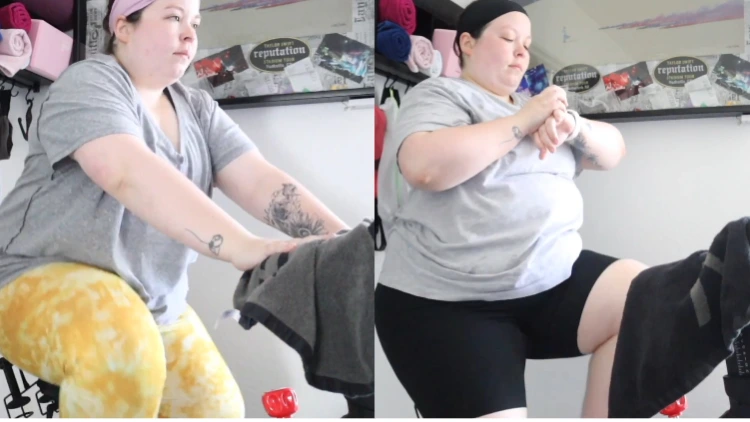
Many beginners and individuals looking to lose weight frequently ask about the ideal frequency for riding their Peloton.1 Even experienced Peloton users often question whether they are cycling too often or not enough.
To be fair, there are a lot of important factors to keep in mind to determine the frequency you should ride Peloton but luckily we’ll break down exactly how to determine how many days per week you should ride with a proven method to make sure you’re not cycling too much, or too little.
In addition, we’ll cover how to spot fatigue, when to incorporate rest days, and stationary bike weight loss before and after results and pictures of others who used rest days vs those who had results from cycling everyday.
Is Riding Peloton Daily a Good Idea?
It depends on a few different things such as one’s current fitness levels, other already established workout routines, health goals, and the intensity and length of the workout. Peloton offers a variety of great workouts and depending on the length and intensity of the workout one can burn between 300 and 700 calories a workout.
With that in mind, it’s important to note the intensity and drain the workout could potentially put on one’s body. Finding a healthy balance between exercising and resting is crucial to see success alongside improving one’s overall health.
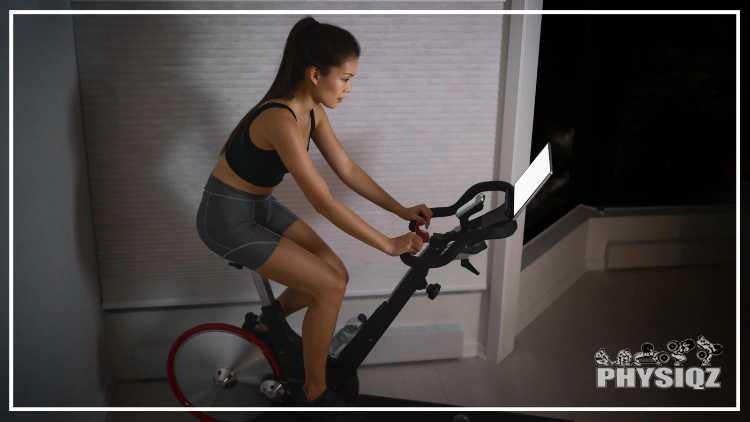
Source: Maridav via Canva.com2
When first beginning a regular workout routine and when specifically embarking on a peloton workout journey, it’s beneficial to start slow and small.3 Starting small and progressively building on the intensity and duration can present many benefits such as preventing initial soreness and potential burnout while also building confidence and a love of the new exercise which will hopefully develop into a strong, regular routine.
For a more seasoned biker, riding every day would be something one could do but it is still recommended to remain mindful of body pains and soreness and take breaks when necessary, whether that be skipping a workout one day or giving your body extra care through stretching or massage.
The ultimate goal when beginning a new workout routine is sustainability, so slow and steady may be the most manageable way to go to find the perfect workout routine for you.
Optimal Peloton Riding Frequency: How Many Days a Week to Ride?
When determining how often to ride the Peloton a few different things should be considered. The intensity of the workout and whether one is a beginner or an expert will determine how often one should ride a peloton.
Beginners: For those who are brand new to cycling with Peloton, it is recommended to start small and gradually increase the duration and intensity.
When beginning any workout routine, it can feel intimidating and soreness is likely to occur. To help limit soreness and potential injury and to slowly create a cycling habit it is recommended to start with 2-4 rides a week.
Additionally, the duration of the workout should slowly increase and it is advised to start with 15-20 minute long rides. If the ultimate goal is to become a daily Peloton rider, a beginner can start building the daily habit with light rides at about 10 minutes a day.
Additionally, when picking an instructor there is a wide range of instructors who specialize in creating workouts for beginners.
Intermediate: For those who have been cycling for 6-12 months, it’s advised to build on the duration, intensity, and the number of days in a week. When deciding which weekly workout plan will work best, the ultimate goal should be evaluated.
If the goal is to work out 7 days a week, the gradual increase in duration and intensity will look a bit different than someone whose goal is to work out 5 days a week.
For intermediate riders, building up the length of the workout is a great way to easily pump up the intensity. One could increase the length of the ride to 30-45 minutes and build up to 4-5 rides a week.
For someone looking to work out every day, once a regular routine of 4-5 rides a week is established one could jump up to 5-6 days a week and still honor a rest day.
Expert: An expert rider would be one who has been consistently working out for more than a year. At this point, working out 7 days a week would be attainable but it is essential to be in tune with one’s body and honor rest days and breaks as needed.
There is a breadth of research showing that rest and sleep have a positive impact on muscle growth so setting aside time for rest can be just as important as the workout. Additionally, through research, it has been shown that sleep is when a lot of recovery takes place.4
In conclusion, prioritizing sleep at night will be crucial for those who are determined to work out on their Peloton 7 days a week.
Recommended Frequency for Spin Classes & Peloton Rides for Beginners
When first starting any type of workout routine, and spin especially, it is important to start small and slowly and steadily build up the duration, intensity, and how many days a week.
When deciding how often one would like to ride, it’s helpful to consider what one’s exercise goals are long term alongside taking into account what the current exercise routine looks like, if any.
If working out is something totally new, it can be scary to think about taking on a whole new routine alongside battling soreness and body pain. With that in mind, it is helpful for most beginners to start with 2-4 rides a week and slowly increase that number.
Furthermore, setting a shorter workout duration can make the daily workout routine feel more manageable and sustainable to keep up long term. Starting with a 10-minute spin class 2-4 times a week could be a great way to introduce your body to the new movement.
Often when beginning something new, people will look at the big picture and get excited by the ultimate goal but some lose steam and motivation when the steps to get to the ultimate goal are challenging and they come across some failures. An awesome way to battle that is by setting small, weekly goals.
By doing this, one would be setting small goals that are attainable which would lead to success which leads to confidence. As confidence builds so will the intensity and duration of the workout.
Optimal Peloton Riding Frequency for Overweight Individuals
For beginners or those who are overweight, it’s best to start with short, low-intensity sessions on the Peloton and gradually increase both the duration and intensity over time.
In general, aiming for 2-4 rides a week is a great start and there’s no need to go more than this to begin with since it’ll make you so sore you won’t ever want to ride your Peloton again, and you just want enough of a workout to feel a good pump and a little soreness afterwards.
When debating a new cardio workout plan or the frequency in which to workout, it is crucial to consult one’s doctor to make sure the plan would be safe and doctor-approved.
Whether you’re a beginner or someone who has taken spin classes before it is important to listen to one’s body and take breaks and rest days as needed.
Additionally, when weight loss is the goal, it’s important to find a class and exercise routine that burns a lot of calories but is also something that one will enjoy. Having a workout routine to look forward to and that is fun is a fantastic way to establish a routine and create an exercise plan that is long-term.
How To Determine How Often You Should Take Peloton Classes
When determining your Peloton workout frequency, consider your current fitness level. Additionally, it’s crucial to listen to your body and focus on what feels right to avoid accumulating fatigue, particularly when starting a new routine.
There are 3 helpful principles that explain why it’s important to start small and build on them as time goes on: minimum effective volume (MEV), maximum adaptive volume (MAV), and maximum recovery volume (MRV).
Minimum Effective Volume (MEV): This is the bare minimum of sets or workout lengths needed to see muscle growth. Anything below this number may only maintain muscles instead of growing. This number will be determined by one’s current fitness level.
For example, if someone has never trained before the MEV number would be 0 whereas someone who is more experienced would have a higher number. Despite experience, this number is always fairly low as it’s the minimum.
Maximum Adaptive Volume (MAV): The MAV is where progress is made. This number can fluctuate because as one becomes more regular at working out, one’s body and muscles will adapt which means they will be able to handle more weight, reps, duration, and intensity than before.
Maximum Recovery Volume (MRV): The MRV is the maximum sets or workout duration one’s body can handle per week. If someone is consistently working out at this number, their risk for excessive exhaustion is much higher.
In conclusion, it’s very important to be in tune with one’s body and listen to it when a break or rest day is needed. The ultimate goal here is to begin with MEV and work to find MAV, knowing that this number will change as muscle is built.
To put it more simply, start with the very little volume which means little time and resistance on Peloton, and then if you feel stimulated the day of the workout, or are sore the following days, then that was a good amount of volume.
From there, slightly increase the duration of the cycling and/or increase the intensity.
Being flexible and able to change weekly routines as needed will allow one to thrive and find a weekly workout routine that will work best for them.
When To Incorporate Peloton Rest Days & How To Notice Fatigue (Recognize Burnout)
In addition to considering the frequency of Peloton rides, it’s important to recognize signs of burnout and fatigue and to determine when rest days are necessary.
Additionally, when working so hard to build your dream body, it’s important to have a nice balance between rest and recovery, and exercise.
Fatigue is crucial to be aware of because over time it can lead to a muscle’s decline to perform which could negatively impact one’s long-term goals.5 Signs of fatigue to look out for are soreness that is persistent, muscle cramps, slow reactions, feeling overall weaker, or pain.
Typically symptoms of muscle fatigue will go away within 3 to 5 days. If they don’t it most likely means one pushed too hard during the workout and it is imperative to keep that in mind for all future workouts.
When a regular workout routine is established, planning to take a deload week can help combat fatigue and burnout and can be a great way to give your muscles and body a well-deserved break.
A deload week is a week dedicated to rest and preparing the body to come back the following week stronger than before and well rested.
During this week sleep and rest will be prioritized and most often the exerciser will greatly modify all normally planned workouts.
For example, cutting the workout in half, doing fewer exercises, reducing the intensity, or focusing on stretching. If necessary, completely removing all workouts during the week could be a good way to deload and recover.
While the video below appears to be about weight lifting, it applies to any form of exercise because even with cycling or cardio, deloads are fundamental to see continual results and avoid plateaus.
If the exerciser is noticing many symptoms of fatigue, a deload week may be most beneficial. If only a few of the fatigue symptoms are being felt, rest is still important but it may look different from a typical deload week such as doing ½ or ¼ of the typical cycling.
At the end of the day, it is most important to listen to one’s body and be kind and gentle to one’s body and muscles. It’s amazing how many benefits one can feel from taking a break and resting!
Peloton Everyday Results With Before & After Pictures
Taking on the challenge of working out every day with no rests day is no easy feat and as notes, is not even necessary for beginners or those who are overweight.
However, the videos and images below will show some before and after stories of those who took on the challenge while also noting some of the mental barriers they faced during that time.
Emily Shack’s 30-Day Cycling Challenge Results
Emily spent the entire month of April riding her Peloton each day. Throughout the month, she had times when she wanted to quit and fake the workout. Despite those feelings, she stuck it out and did her workouts for 30 days in a row.

Emily Shack on day 30 of her 30-Day Cycling Challenge, weighing 273.6 pounds and feeling proud of her accomplishment. Source: Emily Shack on YouTube1
She documented her entire month’s journey on Youtube through videos of her cycling, weighing in, and progress discussions.
She noted significant changes in her strength and toning in her arms and abs. At the end of the month, she was able to do a lot more core exercises than when she started.
Emily did not focus on changing her diet during this month and weight loss was not the goal this month either.
She focused on strength training on her Peloton each day and did notice strength improvement. From a scale perspective, she started at 281 and ended the month at 273.6.
Connor Miniter Lost 100 Pounds After 6 Months
Connor got to the point where he was the heaviest he had been in his life and realized he needed to make some changes.
He made the goal to ride his Peloton every day, even if it was just for 20 minutes. It is important to note that alongside the Peloton rides, he was also doing strength training.

Connor Miniter, 6 months later, having lost an incredible 106 pounds. Source: Connor Miniter on Yahoo6
After 6 months of riding daily, Connor lost an unbelievable 106 pounds! His best piece of advice was to find an exercise that you enjoy and take progress pictures and measurements to be able to see your success even when you hit bumps along the way.
Vito Polizzi’s Year-Long Peloton Challenge
Vito began 2022 with the New Year resolution of riding his Peloton every single day, at a minimum of 15 minutes a day. 9 months into his goal, fatigue, and exhaustion began to creep in.
He noticed the ride began to feel like a chore and became something he started to dread. Because of the mundaneness, Vito decided it was time for a change.
He began riding his bike outside while using the Peloton app on his phone. This made the activity more enjoyable but overall it wasn’t something he loved anymore.
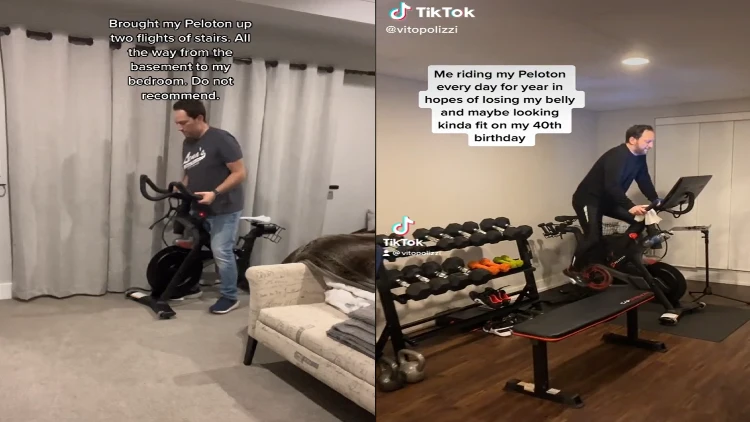
Vito Polizzi, 9 months into his challenge, feeling fatigued and dreading the daily rides. Source: @vitopolizzi on TikTok7
Vito’s story is a great example of how too much of a good thing may not actually be good. By not listening to his body and taking breaks as needed, he got into a routine and was no longer passionate about riding his Peloton.
It was solely just a task he had to do each day. When the passion is gone, it can be very tough to stay consistent.
Peloton Results When Incorporating Rest Days
To compare, let’s look at Peloton results when rest days are incorporated and when there is more flexibility within the workout plan.
Christina Marie’s Results with Riding Every Other Day
Christina purchased her Peloton with the only intention to have a cardio option at home and no specific challenge to follow. After owning the bike for 6 months she passed her 100th ride which equated to riding every other day.
She did not focus on changing her diet in any way and allowed herself to enjoy anything she wanted in moderation. After 6 months of this workout routine, she has lost 10 pounds. She documented her journey on Youtube.
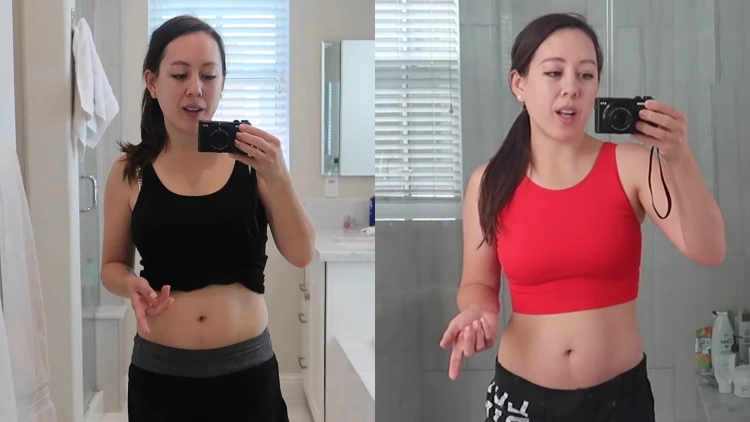
Source: Christina Marie from YouTube8
By having flexibility in when she would ride and how often, Christina seemed to stay very consistent with her working out and her mindset.
Lyndsay Joanne’s Results After 100 Rides
Once Lyndsay made it to her 100th ride it was time to reflect and see the progress she has made so far on her weight loss journey. She completed these rides over a 6 month period so she was not riding daily. During that time she lost 15 pounds.
Lyndsay’s best piece of advice to stick to the Peloton cycling routine was to find classes that are fun and motivating and change the classes up often. Additionally making your workout space fun and exciting can give you an extra boost!
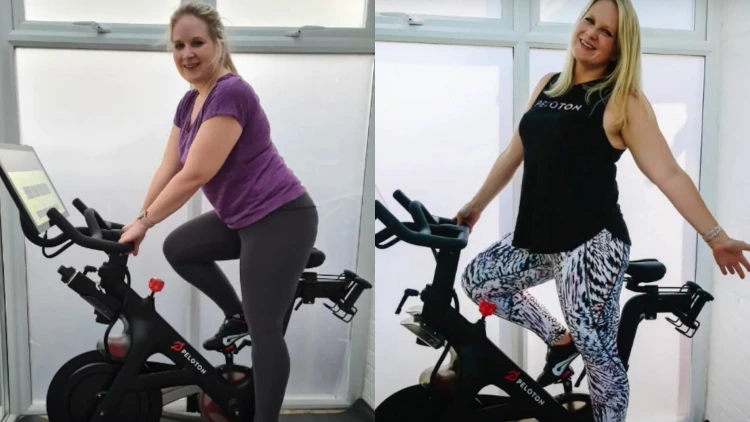
Source: Lyndsay and the Girls | Two Mum family by the sea from YouTube9
Lyndsay’s disco ball Peloton bike set up
Creating a Comprehensive Full Body Program with Peloton Classes
With so many different Peloton classes, it can feel daunting to figure out which class to take, how to fit in as many as possible, and what Peloton workout plan would work best for you. When determining what workout plan is best, think of what long-term goals one would want to achieve.
A program geared towards weight loss will look a bit different than one focused on maintenance and toning.
A term unique to Peloton is power zone training. In short, there are 7 zones, and each one is personalized to the rider.
These zones are determined with a fitness test. Each workout will reference these 7 zones which allow each ride to be personalized and specific to one’s individual needs.
With that in mind, one can be assured that each workout will be personalized to one’s current fitness level and will be attainable, even for beginners.
Alongside offering cycling classes, Peloton offers a range of other workouts such as running, yoga, meditation, rowing, boot camp, stretching, and pilates. It can be very beneficial to change workout routines.
When in a consistent plan that is the same day after day and week after week, one’s body can get used to the movement, and progress can slow down.10 Thus, changing weight amounts, set numbers, and types of workouts not only keep the workout plan exciting and fun but also can allow one to continue to see progress, even months later.
Here is a sample 1 month long program. Something unique about this program is that the focus changes weekly. Under this plan, there are 3 workout days and 2 optional days.
Week 1 (Focus = Starting Things Off Slow & Steady)
Days 1, 3, and 5 are mandatory on week 1 whereas days 2 and 4 are optional for more experienced riders.
Day 1 – 20-Minute HIIT Ride: This is an interval-driven class to boost metabolism. At only 20 minutes long it’s a great workout to begin the month-long plan.
Day 2 (Optional) – 30-Minute Climb Ride: This ride will include climbing up hills which means more resistance. A great strength-building class to prepare one for week number 2.
Day 3 – 20-Minute Low Impact Ride: This is the perfect class to balance sweating and getting a good workout while also being gentle on the joints.
Day 4 (Optional) –10-Minute Foam Rolling; Glutes: After a week of movement, legs and glutes may be sore. This form-rolling class is a great way to finish out the week and add in some recovery time.
Day 5 – 30-Minute Intervals and Arms Ride: At 30 minutes long, the duration is slowly starting to increase. This workout has free weight segments throughout which allows for a full-body workout.
Day 6 – Rest
Day 7 – Rest
Week 2 (Focus = Strength)
Days 1, 3, and 5 are mandatory on week 2 whereas days 2 and 4 are optional for more experienced rides.
Day 1 – 30-Minute HIIT and Hills Ride: A great balance between getting a high heart rate and building strength by battling hills.
Day 2 (Optional) – 10-Minute Low Impact Ride: After a week of focusing on strength, take a moment to move while also recovering.
Day 3 – 45-Minute Climb Ride: Uphill climb workouts are ideal for strength building.
Day 4 – (Optional) –10-Minute Full Body Stretch: After a week full of strength building, really lean into a full body stretch to help each muscle recover.
Day 5 – 45-Minute Intervals and Arms Ride: Building up from the 30-minute class last week, this class will give the whole body a strength boost.
Day 6 – Rest
Day 7 – Rest
Week 3 (Focus = Endurance)
Days 1, 3, and 5 are mandatory on week 3 whereas days 2 and 4 are optional for more experienced riders.
Day 1 – 45-Minute HRZ Endurance Ride: This class will maximize your outputs while also guiding how to conserve your energy for peak endurance.
Day 2 (Optional) – 30-Minute Classic Rock Ride: Or any music of choice. This ride is a bit shorter than the others from this week but will still give a strong pump to finish out the endurance week on top.
Day 3 – 30-Minute Sweat Steady Ride; This class is full of long sustained intervals which is the perfect way to focus on building up endurance.
Day 4 – (Optional) – 45-Minute Power Zone Endurance Ride: During this ride, one will be guided through the specific power zone training ranges from 1-7.
Day 5 –10-Minute Glutes and Legs Stretch: Endurance rides are long, finish out the week with some stretching to get the lower body ready for week 4.
Day 6 – Rest
Day 7 – Rest
Week 4 (Focus = Speed)
Days 1, 3, and 5 are mandatory on week 4 whereas days 2 and 4 are optional for more experienced riders.
Day 1 – 20-Minute Tabata Ride: Tabata rides are an excellent way to hone in on speed. The setup of the Tabata ride allows for recovery time with the ability to go all out while working.
Day 2 (Optional) – 10-Minute Hip and Lower Back Stretch: After a week focused on speed and a lot of time sitting in the saddle, one may notice more hip and lower back tightness. This would be the perfect way to finish out the speed week.
Day 3 – 30-Minute HIIT Ride: HIIT classes are complete with short bursts of energy and speed alongside recovery time. A perfect way to focus on speed.
Day 4 (Optional) – 30-Minute Power Zone Ride: Racing through the power zone training ranges, this ride will hit endurance, strength, and speed.
Day 5 –10-Minute Full Body Stretch: To close out a month full of exercises, give the body a break and some recovery time to stretch.
Day 6 – Rest
Day 7 – Rest
At the end of the day, the most important thing when figuring out a workout plan is finding a workout you enjoy which will help you stick to your goals and see success.11
When determining the ideal frequency for riding a Peloton, it’s important to establish a workout routine that you enjoy and look forward to, as this is key to achieving success and seeing results.
Frequently Asked Questions
When Riding My Peloton What Should Rest Days Look Like?
Some ideas of what a rest day could look like are: going for a walk, stretching or foam rolling, and getting a few extra hours of sleep. Participating in some sort of movement on the rest day can be crucial as research has shown active recovery of the fatigued muscle can lead to faster recovery.
What Day Should I Rest?
Often it’s recommended to take a rest day every 2 to 4 days but ultimately having flexibility in the workout plan is ideal as one can listen to their body and take days off as needed.
References
1Emily Shack. “I rode the Peloton bike every day for 30 days and this happened!! // Plus size fitness journey.” YouTube, 15 May 2022, Accessed 4 April 2023. <https://www.youtube.com/watch?v=uRwTQQ5Mdug>
2Maridav. “Indoor workout using Stationary Bike during Online Classes on Smart Fitness Equipment for Cycling Exercise.” Canva, 16 November 2008. Accessed 15 April 2023. <https://www.canva.com/photos/MAD6gVD1nFk-indoor-workout-using-stationary-bike-during-online-classes-on-smart-fitness-equipment-for-cycling-exercise/>
3U.S. Department of Health and Human Services. (2017). Tips for Starting Physical Activity | NIDDK. National Institute of Diabetes and Digestive and Kidney Diseases. <https://www.niddk.nih.gov/health-information/weight-management/tips-get-active/tips-starting-physical-activity>
4Underwood, J., & White, K. (2022). Sleep and Recovery. Life of an Athlete. <https://www.wm.edu/offices/sportsmedicine/_documents/sleep-manual>
5Enoka, R. M., & Duchateau, J. (2008). Muscle fatigue: what, why and how it influences muscle function. The Journal of Physiology. <https://www.ncbi.nlm.nih.gov/pmc/articles/PMC2375565/>
6Connor Miniter. “Daily Peloton Workouts Helped Me Lose 100 Pounds in 6 Months and Get Buff.” Yahoo, 6 January 2021, Accessed 4 April 2023. <https://finance.yahoo.com/news/daily-peloton-workouts-helped-lose-142700240.html?guce_referrer=aHR0cHM6Ly93d3cuZ29vZ2xlLmNvbS8&guce_referrer_sig=AQAAAII8o3ktlelcIUe_WN_qQHksgfrNu8paC7o59B2kjpNWiS7mFDqC0NvMnv3TGP8ATzi5FNtTMiVLJ7BRleWSdFA1qMJGOxAwOVo0dfCMpPn>
7@vitopolizzi. TikTok, Accessed 4 April 2023. <https://www.tiktok.com/@vitopolizzi/video/7146758065126116654?is_copy_url=1&is_from_webapp=v1>
8Christina Marie. “Peloton Before & After 6 Month Results + Is It Still Worth It?” YouTube, 11 July 2020. Accessed 15 April 2023. <https://www.youtube.com/watch?v=MOKajDI4tdw>
9Lyndsay and the Girls | Two Mum family by the sea. “Peloton Weight Loss before & after 100 rides + exercise motivation tips for mums!” YouTube, 26 September 2021. Accessed 15 April 2023. <https://www.youtube.com/watch?v=TTIIbNdkj9k>
10Peterson, M. D., Pistilli, E., Haff, G., Hoffman, E. P., & Gordon, P. M. (2010). Progression of volume load and muscular adaptation during resistance exercise. National Library of Medicine. <https://www.ncbi.nlm.nih.gov/pmc/articles/PMC4215195/>
11Hagberg, L. A., Lindahl, B., Nyberg, L., & Hellenius, M. L. (2008). Importance of enjoyment when promoting physical exercise. Scand J Med Sci Sports. <https://pubmed.ncbi.nlm.nih.gov/18694433/>